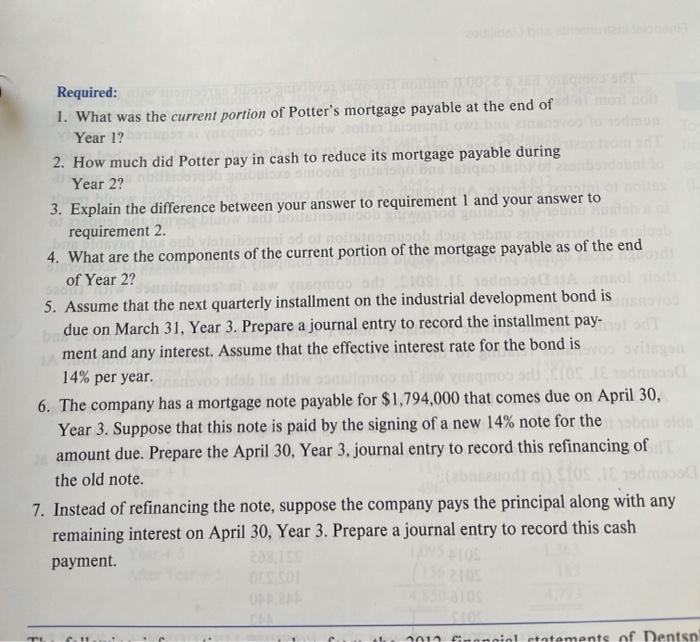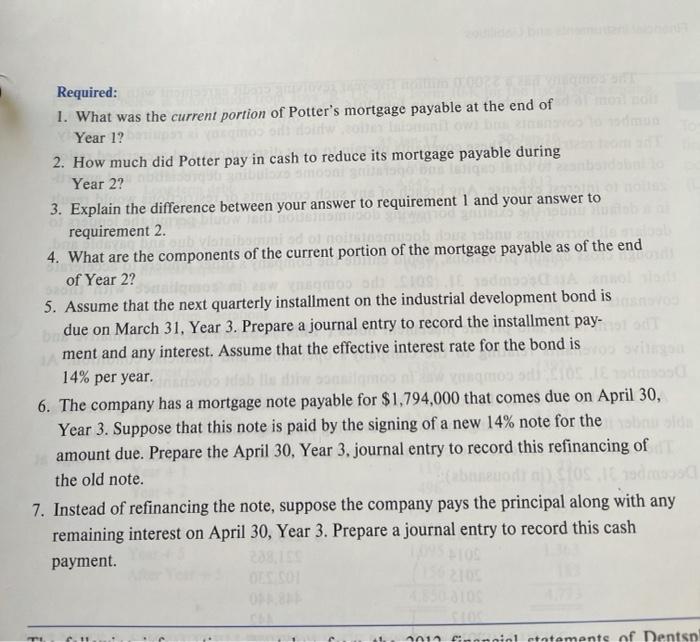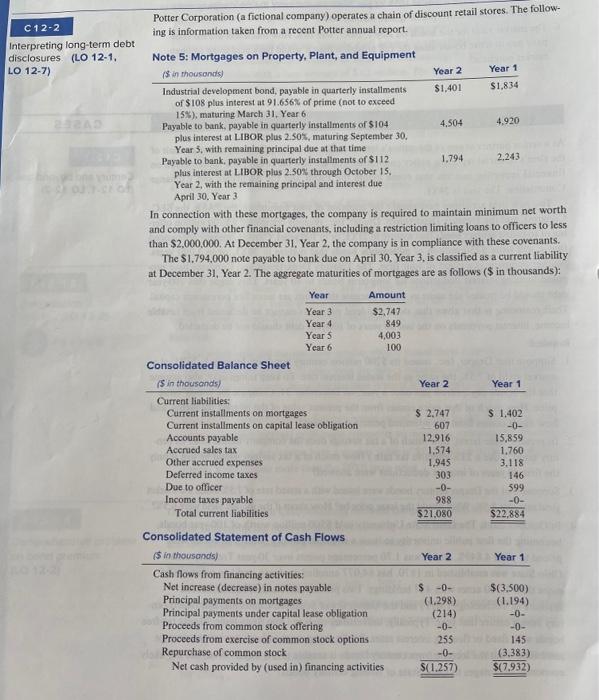Required: 1. What was the current portion of Potter's mortgage payable at the end of Year 1? 2. How much did Potter pay in cash to reduce its mortgage payable during Year 2? 3. Explain the difference between your answer to requirement 1 and your answer to requirement 2. 4. What are the components of the current portion of the mortgage payable as of the end of Year 2? 5. Assume that the next quarterly installment on the industrial development bond is due on March 31, Year 3. Prepare a journal entry to record the installment pay- ment and any interest. Assume that the effective interest rate for the bond is 14% per year. 6. The company has a mortgage note payable for $1,794,000 that comes due on April 30, Year 3. Suppose that this note is paid by the signing of a new 14% note for the amount due. Prepare the April 30, Year 3. journal entry to record this refinancing of the old note. nenoritos, tad mano 7. Instead of refinancing the note, suppose the company pays the principal along with any remaining interest on April 30, Year 3. Prepare a journal entry to record this cash payment. 2012 finanninl statements of Dentsp Required: 1. What was the current portion of Potter's mortgage payable at the end of Year 1? 2. How much did Potter pay in cash to reduce its mortgage payable during Year 2? 3. Explain the difference between your answer to requirement 1 and your answer to requirement 2. 4. What are the components of the current portion of the mortgage payable as of the end of Year 2? 5. Assume that the next quarterly installment on the industrial development bond is due on March 31, Year 3. Prepare a journal entry to record the installment pay- ment and any interest. Assume that the effective interest rate for the bond is 14% per year. 6. The company has a mortgage note payable for $1,794,000 that comes due on April 30, Year 3. Suppose that this note is paid by the signing of a new 14% note for the amount due. Prepare the April 30, Year 3. journal entry to record this refinancing of the old note. nenoritos, tad mano 7. Instead of refinancing the note, suppose the company pays the principal along with any remaining interest on April 30, Year 3. Prepare a journal entry to record this cash payment. 2012 finanninl statements of Dentsp Potter Corporation (a fictional company) operates a chain of discount retail stores. The follow- ing is information taken from a recent Potter annual report. C12-2 Interpreting long-term debt disclosures (LO 12-1. LO 12-7) 4.920 Note 5: Mortgages on Property, Plant, and Equipment (8 in thousands) Year 2 Year 1 Industrial development bond, payable in quarterly installments $1,401 $1,834 of $108 plus interest at 91.656% of prime (not to exceed 15%), maturing March 31, Year 6 Payable to bank, payable in quarterly installments of $104 4,504 plus interest at LIBOR plus 2.50%, maturing September 30, Year 5, with remaining principal due at that time Payable to bank, payable in quarterly installments of $112 1,794 2.243 plus interest at LIBOR plus 2.50% through October 15. Year 2, with the remaining principal and interest due April 30. Year 3 In connection with these mortgages, the company is required to maintain minimum net worth and comply with other financial covenants, including a restriction limiting loans to officers to less than $2,000,000. At December 31. Year 2, the company is in compliance with these covenants. The $1.794.000 note payable to bank due on April 30. Year 3. is classified as a current liability at December 31, Year 2. The aggregate maturities of mortgages are as follows ($ in thousands): Year Amount Year 3 $2.747 Year 4 849 Year 5 4,003 Year 6 100 Consolidated Balance Sheet Year 2 Year 1 $ 1.402 (s in thousands Current liabilities: Current installments on mortgages Current installments on capital lease obligation Accounts payable Accrued sales tax Other accrued expenses Deferred income taxes Due to officer Income taxes payable Total current liabilities $ 2,747 607 12,916 1.574 1.945 303 -- 988 $21.080 15,859 1.760 3.118 146 599 -0- $22.884 Year 2 Year 1 Consolidated Statement of Cash Flows ($ in thousands) Cash flows from financing activities: Net increase (decrease) in notes payable Principal payments on mortgages Principal payments under capital lease obligation Proceeds from common stock offering Proceeds from exercise of common stock options Repurchase of common stock Net cash provided by (used in) financing activities $ -0- (1.298) (214) -0- 255 -0- $(1.257 $(3.500) (1.194) -0- -0- 145 (3.383) $(7.932) Required: 1. What was the current portion of Potter's mortgage payable at the end of Year 1? 2. How much did Potter pay in cash to reduce its mortgage payable during Year 2? 3. Explain the difference between your answer to requirement 1 and your answer to requirement 2. 4. What are the components of the current portion of the mortgage payable as of the end of Year 2? 5. Assume that the next quarterly installment on the industrial development bond is due on March 31, Year 3. Prepare a journal entry to record the installment pay- ment and any interest. Assume that the effective interest rate for the bond is 14% per year. 6. The company has a mortgage note payable for $1,794,000 that comes due on April 30, Year 3. Suppose that this note is paid by the signing of a new 14% note for the amount due. Prepare the April 30, Year 3. journal entry to record this refinancing of the old note. nenoritos, tad mano 7. Instead of refinancing the note, suppose the company pays the principal along with any remaining interest on April 30, Year 3. Prepare a journal entry to record this cash payment. 2012 finanninl statements of Dentsp Required: 1. What was the current portion of Potter's mortgage payable at the end of Year 1? 2. How much did Potter pay in cash to reduce its mortgage payable during Year 2? 3. Explain the difference between your answer to requirement 1 and your answer to requirement 2. 4. What are the components of the current portion of the mortgage payable as of the end of Year 2? 5. Assume that the next quarterly installment on the industrial development bond is due on March 31, Year 3. Prepare a journal entry to record the installment pay- ment and any interest. Assume that the effective interest rate for the bond is 14% per year. 6. The company has a mortgage note payable for $1,794,000 that comes due on April 30, Year 3. Suppose that this note is paid by the signing of a new 14% note for the amount due. Prepare the April 30, Year 3. journal entry to record this refinancing of the old note. nenoritos, tad mano 7. Instead of refinancing the note, suppose the company pays the principal along with any remaining interest on April 30, Year 3. Prepare a journal entry to record this cash payment. 2012 finanninl statements of Dentsp Potter Corporation (a fictional company) operates a chain of discount retail stores. The follow- ing is information taken from a recent Potter annual report. C12-2 Interpreting long-term debt disclosures (LO 12-1. LO 12-7) 4.920 Note 5: Mortgages on Property, Plant, and Equipment (8 in thousands) Year 2 Year 1 Industrial development bond, payable in quarterly installments $1,401 $1,834 of $108 plus interest at 91.656% of prime (not to exceed 15%), maturing March 31, Year 6 Payable to bank, payable in quarterly installments of $104 4,504 plus interest at LIBOR plus 2.50%, maturing September 30, Year 5, with remaining principal due at that time Payable to bank, payable in quarterly installments of $112 1,794 2.243 plus interest at LIBOR plus 2.50% through October 15. Year 2, with the remaining principal and interest due April 30. Year 3 In connection with these mortgages, the company is required to maintain minimum net worth and comply with other financial covenants, including a restriction limiting loans to officers to less than $2,000,000. At December 31. Year 2, the company is in compliance with these covenants. The $1.794.000 note payable to bank due on April 30. Year 3. is classified as a current liability at December 31, Year 2. The aggregate maturities of mortgages are as follows ($ in thousands): Year Amount Year 3 $2.747 Year 4 849 Year 5 4,003 Year 6 100 Consolidated Balance Sheet Year 2 Year 1 $ 1.402 (s in thousands Current liabilities: Current installments on mortgages Current installments on capital lease obligation Accounts payable Accrued sales tax Other accrued expenses Deferred income taxes Due to officer Income taxes payable Total current liabilities $ 2,747 607 12,916 1.574 1.945 303 -- 988 $21.080 15,859 1.760 3.118 146 599 -0- $22.884 Year 2 Year 1 Consolidated Statement of Cash Flows ($ in thousands) Cash flows from financing activities: Net increase (decrease) in notes payable Principal payments on mortgages Principal payments under capital lease obligation Proceeds from common stock offering Proceeds from exercise of common stock options Repurchase of common stock Net cash provided by (used in) financing activities $ -0- (1.298) (214) -0- 255 -0- $(1.257 $(3.500) (1.194) -0- -0- 145 (3.383) $(7.932)









